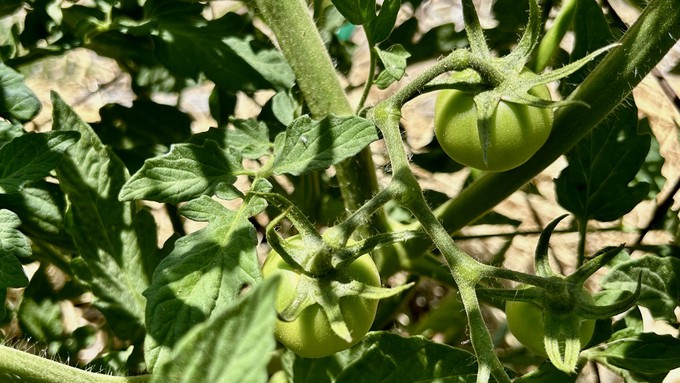
Rare August rain could arrive Friday; be ready for a 25-degree swing in high temperatures

The cooler weather this week should allow tomatoes to set new fruit, before a return of triple-digit temperatures. Kathy Morrison
Here’s something you don’t often hear in August in Sacramento: “Keep your umbrella handy.”
According to the National Weather Service, an unusual and strong weather system will blow into Northern California on Thursday night along with the possibility of thunderstorms. This cold front will drop temperatures as well as some precipitation.
As this “uncommon” weather system moves through, Sacramento has a 48% chance of rain on Friday afternoon and evening, says the weather service. The highest probability of rain is north of Interstate 80 including the possibility of cloud bursts and small hail.
Wet or not, Friday (Aug. 23) will seem downright chilly. Sacramento’s high temperature is forecast to be only 75 degrees – almost 20 degrees below normal for that date. Cloudy conditions will keep temperatures cool on Saturday (with an expected high of 81) before the heat returns.
And that warm-up will be fast; the expected high in Sacramento next Tuesday is 100 degrees.
Enjoy this cool streak while it lasts – and keep an eye on your tomatoes. If they had flowers bloom during recent cooler days, they’re likely setting fruit now. Fertilize them with some tomato food high in phosphate and potassium (the second and third macro-nutrient numbers on the fertilizer bag). That will help those baby tomatoes grow.
Also, deep water tomatoes before and after feeding. To help those vines hold onto their fruit, make sure their soil stays evenly moist during next week’s rapid warm-up.
Yo-yo temperatures can confuse flowering plants, especially roses. Blind shoots – stems with no terminal bud – are common on rose bushes after sudden temperature drops or increases. Blind shoots will never bloom; they just keep growing more leaflets. Snip them off (pruning about a half inch above a five-leaf leaflet) to prompt the bush to push out new shoots with buds.
While you’re at it, remove spent blooms on bushes, too. That removes a source of fungal disease as well as cues the bush to push out more flowers. Expect the new roses to open in six to eight weeks – just in time for fall bouquets.
For more on Sacramento weather: https://www.weather.gov/sto/.
Comments
0 comments have been posted.Sacramento Digs Gardening to your inbox.
Food in My Back Yard Series
April 1: Don't be fooled by these garden myths
March 25: Fertilizer tips: How to 'feed' your vegetables for healthy growth
March 18: Time to give vegetable seedlings some more space
March 11: Ways to win the fight against weeds
March 4: Potatoes from the garden
Feb. 25: Plant a fruit tree now -- for later
Feb. 18: How to squeeze more food into less space
Feb. 11: When to plant? Consider staggering your transplants
Feb. 4: Starting in seed starting
Sites We Like
Garden Checklist for week of March 30
Your garden doesn’t mind April showers. Get busy now to enjoy those future flowers.
* Get ready to swing into action in the vegetable garden. As nights warm up over 50 degrees, start setting out tomato, pepper and eggplant transplants.
* From seed, plant beans, beets, cantaloupes, carrots, corn, cucumbers, melons, pumpkins, radishes and squash. (Soak beet seeds overnight in water for better germination,)
* Plant onion sets.
* In the flower garden, plant seeds for asters, cosmos, celosia, marigolds, salvia, sunflowers and zinnias.
* Transplant petunias, zinnias, geraniums and other summer bloomers.
* Plant perennials and dahlia tubers for summer bloom.
* Transplant lettuce and cabbage seedlings.
* April is the last chance to plant citrus trees such as dwarf orange, lemon and kumquat. These trees also look good in landscaping and provide fresh fruit in winter.
* Smell orange blossoms? Feed citrus trees with a low dose of balanced fertilizer (such as 10-10-10) during bloom to help set fruit. Keep an eye out for ants.
* Apply slow-release fertilizer to the lawn.